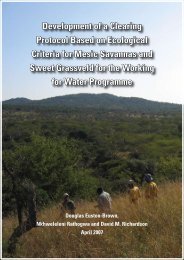Metsi Consultants - DWA Home Page
Metsi Consultants - DWA Home Page
Metsi Consultants - DWA Home Page
You also want an ePaper? Increase the reach of your titles
YUMPU automatically turns print PDFs into web optimized ePapers that Google loves.
METSI CONSULTANTS: SUMMARY OF MAIN FINDINGS FOR PHASE 1 DEVELOPMENT<br />
I. TERMS OF REFERENCE FOR CONTRACT 648 (IFR STUDY)<br />
CONTRACT TITLE<br />
ANNEX B. TERMS OF REFERENCE<br />
LHDA CONTRACT 648: THE ESTABLISHMENT AND MONITORING OF INSTREAM FLOW REQUIREMENTS<br />
(IFR) FOR RIVER COURSES DOWNSTREAM OF LHWP DAMS<br />
OBJECTIVES OF THE STUDY<br />
The objectives of the study are:<br />
• to assess the instream flow requirement of the Senqu, lower Senqunyane, lower Malibamats’o, and lower<br />
Matsoku Rivers;<br />
• to assess the long-term impacts of the modified flow regimes resulting from the construction of the proposed<br />
Lesotho Highland Water Project (LHWP) dams on the ecosystems of the study rivers, and to provide<br />
recommendations for mitigation against, and compensation for, significant impacts linked with the proposed<br />
projects;<br />
• to recommend a long-term programme to monitor the efficacy of the IFR releases, the results of which can<br />
be used to adjust the IFR as required.<br />
TASK 1: IFR METHODOLOGY, PARAMETERS AND SITES<br />
(a) The study team shall review all currently accepted methodologies for determining IFR. Particular reference<br />
shall be given to the methods used for determining IFR in southern Africa and similar environments.<br />
Particular efforts shall be made towards the use of comprehensive flow regimes that cater for all river<br />
ecosystem components, such as, fish, aquatic invertebrates, water quality, riparian vegetation and the<br />
abiotic environment. The advantages and disadvantages of each method shall be identified and pertinently<br />
reviewed. The study team shall provide a description of variables to be measured for each methodology<br />
selected and provide full justification for its application on a long-term basis to the LHWP. Review and<br />
approval of the proposed methodology shall be obtained from the Panel of Experts before proceeding to<br />
the subsequent tasks.<br />
(b) The study team shall conduct a preliminary reach analysis of each river based on air photo interpretation,<br />
satellite imagery and any other accepted method. Classification shall take into account flow<br />
characteristics, tributary inflows, geomorphology and geology, land-use, riparian characteristics, scenic<br />
resources and other defined characteristics. Reach classification shall be confirmed by field<br />
reconnaissance.<br />
(c) The salient factors exerting a dominant influence on each reach, including morphological, hydrological,<br />
land-use or other factors, shall be identified and described.<br />
(d) Hydrological characteristics of each reach shall be described and quantified to the extent possible in each<br />
of the rivers over the full range of natural conditions including very wet years and very dry years.<br />
Report No. 678-F-001 B-1

















